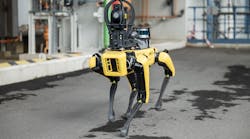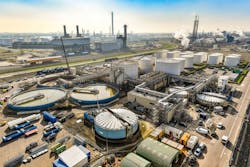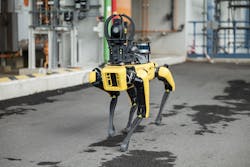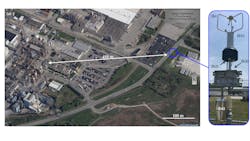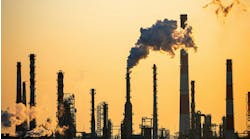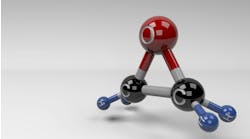Satellites and Robot Dogs Tackle Fugitive Emissions
Technologies being developed to detect fugitive and other emissions from chemical companies range from constellations of satellites in space to dog-like robots on-site – and almost everything in between.
ExxonMobil is carrying out one of the most comprehensive detection efforts as part of its methane reduction program.
Late last year, the company opened its Center for Operations and Methane Emissions Tracking (COMET) in Houston to aid in tracking and responding to leaks and other fugitive emissions across Exxon's 1.8 million acres in the Permian Basin.
As part of an eight-month project to evaluate 30 emissions-detecting technologies, the company is using satellites, aircraft, drones, facility-scale near-continuous monitoring via fixed cameras and sensors, on-the-ground manual leak detection, and what it claims is a first-of-its-kind stratospheric balloon with hyperspectral sensors.
The latter involves collaboration with San Francisco-based Scepter and Amazon Web Services (AWS), Seattle.
Scepter specializes in using global Earth and space-based data to measure air pollution in real-time. The company has been working with ExxonMobil to optimize sensors that orbit satellites, forming a constellation that, by 2026, will be used to enable real-time, continuous monitoring of methane emissions from oil and gas operations on a global scale.
As part of this effort, the companies are conducting stratospheric balloon missions to test the technology in high-altitude conditions.
Bringing in AWS is described as an important next step to developing a fusion and analytics platform.
The technologies already are enabling ExxonMobil to achieve sensitive, specific detection of methane emissions. These include aerial detection thresholds ranging from 50 kg/hr to less than three kg/hr on hundreds of sites every day, and facility-scale, near-continuous monitoring using fixed cameras and sensors, with limits from 25 kg/hr to less than 1 kg/hr depending on technology placement and wind conditions.
Since initiating its methane reduction program, ExxonMobil says it has conducted more than 39,000 leak surveys on more than 9.2 million components at its facilities.
In a note to shareholders on May 15, 2023, the company said it is still working to enhance emission quantification, collaboration and communication.
“Quantification technologies are still emerging and do not currently provide consistent, repeatable results at the site/point-source level. In many countries where we have operations, there are significant access and security issues, as well as a limited number of providers to support measurement and quantification technologies. Currently, there are no standard protocols to incorporate direct measurement into the quantification of methane emissions,” the note reads.
However, ExxonMobil also pointed out that it recently joined the Gas Technology Institute-led Veritas (methane emissions measurement and verification) initiative to develop and implement a standardized, science-based, technology-neutral, measurement-informed approach to reporting methane emissions.
Rise Of The Inspection Robots
Other companies, including Evonik, Shell, BP and Wacker Chemie, are testing robots as part of their fugitive and other emissions detection strategies.
Evonik, Essen, Germany, has been testing Spot, an agile mobile robot developed by Boston Dynamics, Waltham, Massachusetts, since January 2022. The robot, which can carry and power up to 14kg of inspection equipment, follows automated inspection routes at a test facility.
It uses sensors, an infrared camera and an optical camera supplied by robot specialist Energy Robotics, Darmstadt, Germany.
Evonik says Spot easily navigates the facility while recording and transmitting information about onsite operations. For example, it reads analog devices and uses thermal imaging to detect defects in pipes and monitor temperature levels — even from local sensors and places difficult for people to access.
The collected data helps detect anomalies, such as fugitive emissions, excessive temperatures, leaks or contamination at an early stage, and monitor flow rates and pressure values.
"Energy Robotics' autonomous inspection solution has convinced us that mobile robots are able to perform inspection tasks consistently and to reliably provide accurate information. We are now testing this technology," says Uwe Piechottka, with process technology and engineering/digital process technologies at Evonik. Piechottka adds that the goal is to use autonomous robots to keep people out of dangerous or health-threatening work environments while increasing the quality and frequency of inspections.
According to an Evonik spokesman, the company is currently testing two different walking robots and one with wheels. The trial finishes in July 2023, with the expectation that further development work is needed for robots to fully meet Evonik’s expectations.
“Autonomous navigation of a robot in a complex and changing environment like a plant is basically possible. To completely replace a human being in a plant, the skills of the robot — like seeing, smelling and hearing — need further development. Also, it is currently a matter of cost-benefit consideration. Besides plant surveillance applications, the technology could be used for site security and logistics tasks. Once development is concluded and cost-benefit considerations are solved, the technology might have a chance to be used across Evonik sites in the future,” he explains.
However, he also adds that the company does expect the use of robotic technology to become an issue in the modern chemical industry in the medium term — and to offer even more technical possibilities in the future.
Meanwhile, Evonik continues to trial classic sensors, both fixed and carried by operators, to improve detection of fugitive emissions and other issues.
See Spot Go
Shell is no stranger to autonomous robot technology, either, and has been testing a diverse fleet of them at its Pernis refinery in Rotterdam, The Netherlands, for a number of years (Figure 1). Initially, they were tested to sniff out fugitive emissions, with a secondary role in data collection.
As the trial progressed, the company improved maintenance and asset integrity at Pernis, with modified robots able to perform inspections in potentially explosive environments.
The company also is testing Spot, with Shell Energy and Chemicals manager of robotics Berry Mulder noting that having legs has allowed it to access places where robots with tracks could not.
“Starting in July 2023, autonomous robots and IoT sensors will carry out all visual inspection tasks normally done by our operators,” shares a Shell spokeswoman.
“After a development period of three years, the team has implemented new ways of working where the field operators receive, on their tablets, at the beginning of their shift what actions have to be taken in the plant. Until now, our operators spent a lot of time checking the equipment in the plant visually. This new digital technology is a huge time saving for our operators, making their job more interesting and fulfilling at the same time. The robots enable remote monitoring and operations of our plants,” she adds.
At the same time, she notes, the extra monitoring allows Shell to operate its plants more efficiently and reliably while reducing emissions and flaring during process upsets.
As part of its strategy to achieve net zero emissions by 2050, BP is implementing and scaling new digital technologies, including sensors, algorithms and other advanced tools to reduce or remove the need for operators to be present at remote and hazardous locations.
BP, too, has been testing different robots.
In Spot’s case, the first step was to perform a proof of concept to verify it could move reliably in an industrial environment. This test was performed at the Texas A&M engineering extension service facility, which contains props and features that mimic a typical production site.
The tests went well, but BP initially found Spot less reliable on industrial-grade grated stairs. Boston Dynamics closed this gap in functionality and helped BP find vendors who could provide sensor payloads for their specific applications, such as a methane sensor that shuts Spot down in environments where gas levels present a high risk.
The robot was then tested for a week at BP’s Whiting refinery near Chicago.
The company is now exploring the use of Spot and other robots with light detection and ranging sensor payloads for generating 3D models or digital twins.
In time, BP hopes to develop all its robots’ programmed capabilities so they have a practical understanding of the site, and not only gather data but also analyze what that data means, and potentially take action, if necessary.
In January 2022, Spot joined a wiping robot and several vacuum robots in a monitoring trial at Wacker Chemie’s Nünchritz plant in Germany. The plant is the company’s main production site for silicon-based chemicals.
Their use came about as part of an operational excellence pilot project being carried out by a team at the site’s polysilicon plant.
Initial deployment of Spot was limited as the robot was neither equipped for potentially explosive atmospheres, nor able, for safety reasons, to be used in stairwells.
Instead, it patrolled for four to six hours a day in and around the site’s deposition plant to detect and monitor leaks, pressures, temperatures and vibrations (Figure 2).
However, Wacker could not share what it considers highly confidential information about if and where Spot and the other robots are working now, any benefits accrued in terms of detecting and dealing with fugitive emissions, or whether more advanced robots and/or sensors are currently in use or under development.
Fence Sensing With SPods
Looking in a different direction, the next-generation emissions measurement research team from the U.S. Environmental Protection Agency (EPA) is collaborating with industry, state and local regulators, communities and technology companies to develop innovative technical approaches for detecting and controlling fugitive industrial volatile organic compound (VOC) emissions.
Technologies under investigation include fenceline monitoring with VOC sensor pods (SPods), odor VOC emissions trackers, remotely operated canister grab sampling (CGS) systems and sensor network leak detection systems.
Prototype SPods were first deployed at a secure EPA testing site near multiple chemical facilities operated by companies including American Synthetic Rubber, Borden Chemical, DuPont Dow Elastomers, Noveon, Dow Chemical and Zeon Chemicals at Rubbertown, Louisville, Kentucky.
Residents had long raised concerns about poor air quality and odors emanating from the chemical companies operating there.
So, the EPA carried out a seven-month monitoring study using experimental SPods fitted with 30-second duration CGS systems.
The study’s objective was to better understand lower-cost 10.6 eV photoionization detector (PID)-based VOC sensors and investigate their use in near-source emissions detection applications.
According to an article in a 2022 issue of Sensors journal, prototype SPods containing PID sensor elements from two different manufacturers yielded between 78% and 86% valid data over the study, producing a dataset of over 120,000 collocated pair fenceline measurements averaged into five-minute datapoints.
Ten-second time-resolved SPod data from an elevated fenceline sensor signal day are presented in the paper, illustrating source emission detections from the direction of a chemical facility 500 meters west of the monitoring site (Figure 3).
“A SPod-triggered CGS acquired in the emission plume on this day contained elevated concentrations of 1,3-butadiene and cyclohexane [36 part per billion by volume (ppbv) and 637 ppbv, respectively], compounds known to be emitted by this facility,” the authors note.
“Overall, this 19-month study demonstrated reasonable prototype SPod operational performance indicating that improved commercial forms of lower cost PID sensors could be useful for select VOC fenceline monitoring applications,” the article states.
The paper also notes the prototype SPod suffered 20% data loss due to component failures and delays in replacements.
Now, however, sensor instrumentation specialist Sensit Technologies, Valparaiso, Indiana, developed a commercial SPod model to resolve these issues.
“The commercial version of the SPods are currently being evaluated in Louisville, as part of a pilot SPod sensor loan program through EPA Region 4. These devices have also been evaluated in other EPA-led field studies, for example, the Greensboro Storage Tank Assessment with Remote Sensing Technology (G-START) project, in Greensboro, North Carolina,” explains an EPA spokesperson.
